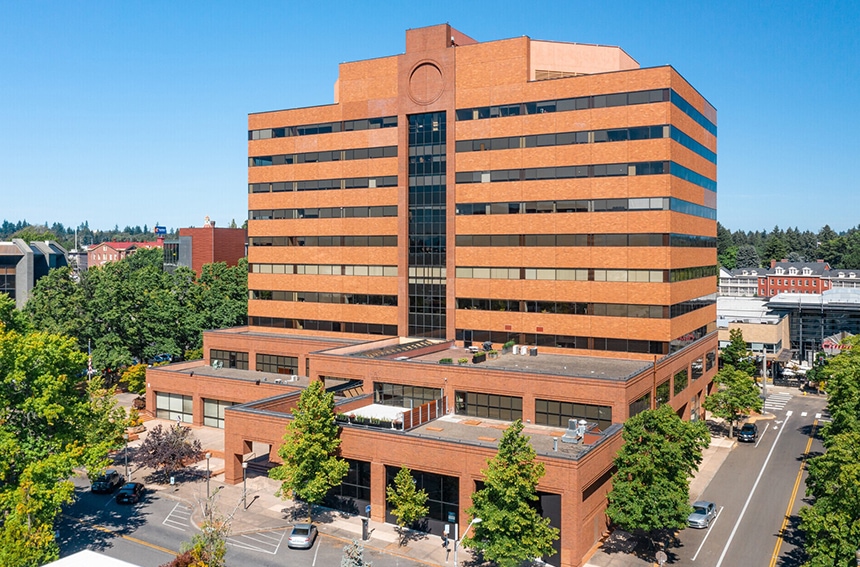Custom
Energy-efficiency equipment not covered by standard incentives may still be eligible for custom incentives. These projects typically require additional energy analysis or other technical assistance. All equipment purchases must be pre-qualified by Energy Trust. In addition, a post-installation verification may be required.
Projects may include:
| Direct Digital Controls | Air Compressors |
| Chillers | Variable Frequency Drives |
| Heat Recovery Systems | Water Filtration Systems |
| Rooftop Units | Retrocommissioning |
| Occupancy Based PTHP Controls |
Interested in joining our Pay for Performance offering?
Pay for Performance allows facility managers to take a holistic look at managing their energy use and earn cash incentives based on the building’s overall energy performance. Smaller projects that are not cost-effective on their own may be paired with other projects that generate more savings. By grouping these projects together, you can make more energy-saving upgrades than if you pursued them individually. Learn more about Pay for Performance.
Contact your Energy Trust Existing Buildings account manager or email existingbuildings@energytrust.org to get more information about custom cash incentives.
-
Find a trade ally contractor.
We can help you get started.
-
Have proposed project analyzed and reviewed by Energy Trust.
-
Get offer from Energy Trust.
-
Accept offer and reserve incentives.
-
Have equipment installed.
-
Submit documentation.
-
Get your incentive.
Note: A post-installation verification may apply.
Energy-efficiency equipment not covered by standard incentives may still be eligible for custom incentives. Cash incentives for qualified custom energy projects are calculated based on estimated annual energy savings at $0.45 per annual kWh and $5 per annual therm.
Energy Trust collaborates with the Smart Building Center, a regional resource for energy efficiency, to provide access to the technical tools needed to identify energy waste within a commercial or industrial operation. The Tool Lending Library consists of 85 different types of diagnostic tools with more than 1,000 pieces of equipment. Check it out here.
Incentives are subject to funding availability and may change.
Oregon law requires customers of Portland General Electric and Pacific Power to pay a three percent public purpose charge. Under its agreement with the Oregon Public Utility Commission, Energy Trust receives and invests some of the funds generated by the public purpose charge to support energy-efficiency projects and assist with the above market costs of new renewable resources. Find out more information about Energy Trust.
Although the payment of the public purpose charge is generally mandatory, certain large electricity consumers (over 1 average megawatt or 8,760,000 kilowatt hours a year) may be eligible to “self-direct” portions of their public purpose charge payments to fund Oregon Department of Energy-certified expenditures at their own facilities. Self-direction is optional, and over time, an entity may change its self-direct status. For more information about self-direction, see Oregon Department of Energy’s website.
Yes, subject to certain limitations and requirements. Whether (and when) you choose to self-direct affects the services and incentives you will be eligible to receive from Energy Trust.
A complete copy of Energy Trust’s Policy on Self-Direction is available for your review. If you are currently self-directing or think you are eligible to self-direct and might decide to do so in the future, you are advised to read this policy prior to participating in any Energy Trust program.
No. You are not allowed to receive Energy Trust incentive funds for any project (i.e., measure) for which self-direction credit is also claimed.
As long as you are not planning to claim self-direction credit for the following measures, a self-director may receive 100% of the standard Energy Trust incentive amount offered by Energy Trust for the following:
- Non-lighting prescriptive measures
- Mid-stream and upstream incentives
- Measures determined by Energy Trust to have modest costs ($5,000 or less per project) and savings, and where application of the self-direct policy’s requirements would unreasonably interfere with our efforts to encourage participation in one of our programs
- For all other measures, you can choose to either:
- Stop using* self-direction credits to reduce your public purpose charge for a period of 36 months at the Oregon Department of Energy-certified site in which case you will be eligible to receive the full (100%) standard Energy Trust incentive amount for your measure, OR
- Continue to use self-direction credits to reduce your public purpose charge at the site and receive up to 50% of the standard Energy Trust incentive
* Energy Trust’s policy does not ask you to stop accumulating self-direction credits for any other (non-Energy Trust funded) energy efficiency or new renewable resource projects you may perform during the 36-month period as long as you do not use them to reduce your public purpose charges during this period. See response to question 6 below.
It is our understanding that Oregon Department of Energy lets you “bank” existing credits and you can resume using them following the 36-month time period; however, we advise you to discuss this issue and verify with Oregon Department of Energy directly.
Yes, new building construction projects that receive Energy Trust incentive funding are subject to the self-direction policy.
Yes, technical analysis studies or feasibility studies that receive Energy Trust incentive funding are subject to the self-direction policy.
You would be eligible to receive 100% of the standard Energy Trust incentive for an energy efficiency project at that site, but only eligible to receive up to 50% of the standard Energy Trust incentive for a new renewable energy project at that site (unless you agree to cease self-directing the renewable portion of the public purpose charge for 36 months – see response to question 5 above).
You would be eligible to receive 100% of the standard Energy Trust incentive for a new renewable energy project at the site, but only eligible to receive up to 50% of the standard Energy Trust incentive for an energy efficiency project at the site (unless you agree to cease self-directing the conservation portion of the public purpose charge at the site for 36 months – see response to question 5 above).
Yes. See responses to questions 9 and 10 above.
You will be required to repay a pro-rated amount of the Energy Trust incentive funding up to a maximum of 50% of the amount you received. Energy Trust uses the following formula to calculate repayment:
- Refund Amount = 0.5 x A x B
- A = total amount of incentives paid
- B = 36 months minus the number of months elapsed since measure installation or completion*, divided by 36
* For energy efficiency projects, Energy Trust typically calculates the completion date as Energy Trust’s incentive payment date. For new renewable resource projects, Energy Trust typically calculates the completion date as the project’s commercial operation date.
Energy Trust will negotiate a payment schedule for the amount of the incentive funds repayment with you; however, the payment must be complete within two years of the date the repayment obligation is triggered.
Energy Trust staff has the discretion to waive the repayment obligation only for projects whose repayment obligation would be $5,000 or less.
Need Help? Contact Us.
¿Necesitas ayuda? Contáctenos. Soporte disponible en español.
1.866.605.1676


